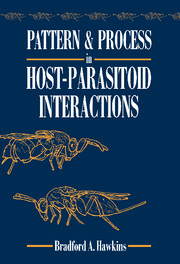4 - Taxonomic composition and generalist versus specialist parasitoids
Published online by Cambridge University Press: 04 May 2010
Summary
Introduction
The previous chapter dealt with factors influencing the total number of parasitoid species that a herbivore species may support. But not all parasitoids that compose a community are identical and interchangeable. Strict quantitative analyzes which ignore the components of parasitoid communities are likely to miss important aspects of community structure and evolution (see for example, Price & Pschorn–Walcher, 1988; Pschorn–Walcher & Altenhofer, 1989; Mills, 1993, 1994), and most of the mechanisms that have been proposed to explain large scale patterns in parasitoid species richness can only be distinguished by comparing their presumed effects on different components of parasitoid communities (Askew & Shaw, 1986; Gauld, 1986; Hawkins, Shaw & Askew, 1992). I now partition the parasitoid assemblages into component parts to examine in more detail parasitoid species richness and to evaluate some of the mechanisms that might be responsible for the patterns found in the preceding chapter.
The two criteria for dividing the parasitoids are their taxonomy and their biology. Parasitoids were distinguished taxonomically as being Hymenoptera or Diptera. Other, minor groups of parasitoids (e.g. Coleoptera) were not considered taxonomically. Within the Hymenoptera, the Ichneumonoidea, Chalcidoidea and other superfamilies were further distinguished. Parasitoids were distinguished biologically as being either idiobionts or koinobionts (sensu Askew & Shaw, 1986).
- Type
- Chapter
- Information
- Pattern and Process in Host-Parasitoid Interactions , pp. 70 - 110Publisher: Cambridge University PressPrint publication year: 1994



